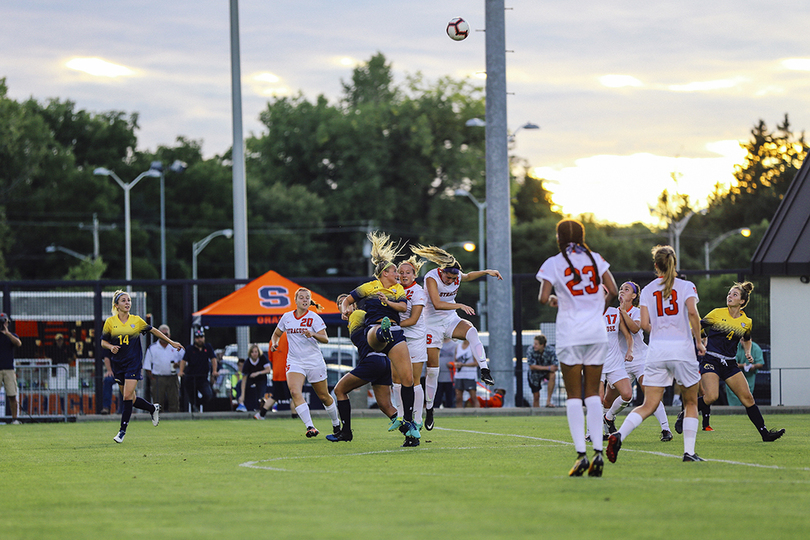Possession-based formation changes put stress on Syracuse’s outside midfielders

Syracuse drops into a 4-5-1 without the ball, packing five players into the midfield. Josh Shub-Seltzer | Staff Photographer
With just over seven minutes remaining in the second overtime period on Sept. 13, Syracuse and Kent State were knotted at one. After Victoria Hill’s ball upfield was intercepted near the halfway line, only four SU players were behind the ball. According to the Orange’s 4-5-1 formation when defending, there should have been nine — all four defenders and five midfielders.
Kent State’s Maddie Holmes gathered the ball in the center of the field and found Vital Kats at the top of SU’s penalty area, who slid it to Isabelle Mihail. Mihail fired a first-time strike that clattered the underside of the crossbar and into the net, ending the game and giving the Golden Flashes a 2-1 victory. Kate Donovan and Molly Nethercott, the right midfielder and right back, were responsible for marking Mihail, but neither was close enough to apply any pressure.
Mihail’s game-winner exposed that Syracuse’s (3-9, 0-4 Atlantic Coast) most effective formation leaves the Orange completely vulnerable when it breaks down.
When the Orange are on the attack, its wingers push up the field to make a 4-3-3 formation. When it loses the ball, the wingers must track back and mark the opposing wingers, creating a 4-5-1 formation. In the 103rd minute against Kent State, SU failed to keep that shape, costing it the game.
“I think you can see when it breaks down, and we’ve conceded because of it,” freshman midfielder Meghan Root said. “It’s really important to quickly transition back into (the 4-5-1) after we lose the ball.”
The effectiveness of the two formations relies almost entirely on the outside midfielders. When SU gains possession of the ball, the left and right midfielders must get wide and up the field, acting as a second and third forward. But when the ball is lost, they have to dart back and mark the opposing outside midfielders. In order to play the position, you have to be ready to run, midfielder Sydney Brackett said.
“There’s no time to rest,” Brackett said.
While SU has looked unsteady when transitioning from offense to defense at times, it also has success employing the two formations.
The Orange succeeded in keeping its shape against Louisville on Sep. 23, Root said. Despite losing 1-0, SU held the Cardinals, who averages 2.5 goals per game this season, scoreless until they broke through with 9 seconds left in the game. In his post-game speech, SU head coach Phil Wheddon praised Syracuse for always having bodies behind the ball, Root said.
In a 1-0 win at Northeastern on Sept. 2, the Orange’s defense held the Huskies scoreless despite surrendering 15 shots — six on target. SU’s defensive shape was compact and consistent throughout the game, Brackett said.
“We just parked the bus in the bottom of the circle (outside the penalty area),” Brackett said of SU’s victory over Northeastern. “We had our four defenders and our five midfielders communicating and staying on their marks.”
To execute the two formations successfully, you have to have the right personnel, Wheddon said. Players must be fit enough to run for 90 minutes. They must be intelligent enough to know when to be attack-minded or conservative. They must communicate and not get caught in transition.
“We looked at the players that we had and said, ‘What system makes the most sense for these players?’” Wheddon said. “We decided on this. It’s a well-known tactic.”
While the system may be the best option for the Orange, Wheddon said, players consistently drew back to the Louisville and Northeastern games as the only examples of 90-minute performances. For now, Wheddon and Syracuse’s players are comfortable using the scheme and have belief it will lead to results, he said.
“For us right now, playing with five in the midfield and transitioning into a 4-3-3 seems to make the most sense,” Wheddon said.





